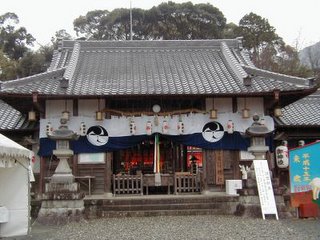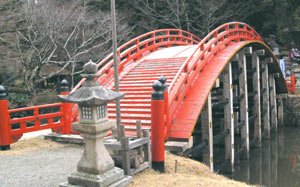:::::::::::::::::::::::::::::::::::::::::::::::::::::::::::::::::::::::::::::::::::::::::::::::::::::
Niutsuhime, Niutsubime 丹生都比女

source : www.pauch.com
Deity of Cinnabar.
As her name says, 丹を生む, she is giving birth to cinnabar.
She is venerated at shrine Niutsuhime-jinja, which is dedicated to the deity of the land protecting the northwestern part of the Kii Mountain Range; an area that includes Koyasan. For this reason it has a close relation to Kongobu-ji temple.
She is related to cinnabar (shu 丹) and then mercury, which was found in the land around Koyasan. When Kukai received the land for building his temple, the natural resources would provide the money for construction of the many temples. The vermillion bridge and shrine buildings in her honor may relate to the cinnabar.
The main statue of the shrine in her honor might well be a piece of cinnabar chrystal, which melts into mercury (cinnabar (mercuric sulfide, ryuuka suigin 硫化水銀). It is a secret statue which nobody has seen yet.
In the Chinese alchemical traditions of Tao, mercury represents the yin principle embedded in yang; mercury is extracted and added to sulphur (yang, cinnabar).
The Tanden 丹田, the Cinnabar field within the human body, is part of that transformation process theory.
Niutsuhime is closely related to the mercury mining sites from Wakayama to Shikoku. One shrine dedicated to Niu Myojin (see below) is situated between Koyasan and Negoro 根来, where the mercury was used for the striking red Negoro laquer ware (Negoro nuri 根来塗(ねごろぬり).
. . . CLICK here for Negoro Laquer Photos !
Following is some reference.
:::::::::::::::::::::::::::::::::::::::::::::::::::::::::::::::::::::::::::::::::::::::::::::::::::::

http://www.jal.com/world/en/guidetojapan/world_heritage/kii/see/index03.html
:::::::::::::::::::::::::::::::::::::::::::::::::::::::::::::::::::::::::::::::::::::::::::::::::::::
Niutsuhime
A female kami and central deity (saijin) of the Niutsuhime Shrine in Katsuragi, Ito District, Wakayama Prefecture. The deity may be the same as the Nihotsuhime seen in the legend of Empress Jingū related in a fragmentary passage of the Harima no kuni fudoki as contained in Shoku Nihongi. The kami is said to be the tutelary of metallic mercury (suigin) and also of water sources (suigen).
According to the Niu Daimyōjin norito, the kami first appeared in Anda Village of Ito District, and after traveling through the region, settled in the location of its current shrine. The kami is also said to have ceded land to Kōbō Daishi (Kūkai) for the purpose of building his temple Kongōbuji, and is thus considered a tutelary of Mt. Kōya.
From the medieval period, Niutsuhime was viewed as the mother of the Buddhist deity Kōya Myōjin, and generally identified with the kami Wakahirume.
Kadoya Atsushi
Copyright (C)2002-2005 Kokugakuin University.
http://eos.kokugakuin.ac.jp/modules/xwords/entry.php?entryID=115
. Wakahirume no mikoto 雅日女尊 .
Shrine Hibita Jinja 比々多神社
:::::::::::::::::::::::::::::::::::::::::::::::::::::::::::::::::::::::::::::::::::::::::::::::::::::
Quote from JAANUS
Niu Myoujin 丹生明神 (Niu Myoojin)
Also Niutsuhime Myoujin 丹生都比売明神. A female mountain deity that resides in Mt. Kouya 高野 . According to legend Kuukai 空海 (774-83, see Kobo Daishi 弘法大師) recieved permission from Nui Myoujin through an oracle to build Kongoubuji 金剛峯寺, his monastery on Mt. Kouya, in 816. In many variants of the legend Nui Myoujin's son (or emanation) *Kariba Myoujin 狩場明神 (also known as Kouya Myoujin 高野明神) appeared as a hunter who led Kuukai to the site.
Niu Myoujin and Kariba Myoujin were adopted as the guardians (chinju 鎮守) of the monastery and, with two other deities added later, were worshipped at the Amano Jinja 天野神社, presently Niutsuhime Jinja 丹生都比売神社, as Kouya Shisho Gongen 高野四所権現 or Kouya Shisha Myoujin 高野四社明神. The word niu is found in the names of places associated with the mining of mercury ore (cinnabar). Scholars suggest that Niu Myojin may have been the deity of clans who did such mining. Mt . Kouya has, for the purposes of mandalas, sixteen peaks, which are represented as eight inner and eight outer petals, and these works combine the Matrix Mandala, *Taizoukai mandara 胎蔵界曼荼羅 and Diamond World Mandala, *Kongoukai mandara 金剛界曼荼羅.
These last two are the diagrams of the two aspects of *Dainichi, representing the realms of dynamic enlightenment and wisdom respectively. The bonji 梵字 (Siddham letters that are the sound symbol of the deity) for these two forms of Dainichi may appear on paintings of Niu Myoujin and her son when they are represented as Shinto deities *kami 神.
In paintings Niu Myoujin may be shown in Japanese Court dress or in Chinese dress and may appear alone, with Kariba, or in larger groups.
© 2001 Japanese Architecture and Art Net Users System.
http://www.aisf.or.jp/~jaanus/deta/n/niumyoujin.htm
. Tengu 妙音坊 Myoon-Bo, Myoonbo. .
The legend of the Tengu from 高野山弁天岳 Mount Bentendake (984 m)
Benzaiten is venerated at the shrine 弁財天社 on this mountain.
Myoon-Bo Tengu lived on a large cedar tree in the compound and protected the shrine.
:::::::::::::::::::::::::::::::::::::::::::::::::::::::::::::::::::::::::::::::::::::::::::::::::::::

弘法大師(中央)Kobo Daishi in the middle
丹生都比売大神(右)Niutsuhime no Okami on the right
高野御子大神(左)Koya Miko no Okami on the left

丹(朱砂=水銀鉱石) susa stone, shusha stone
source : dogunta12
:::::::::::::::::::::::::::::::::::::::::::::::::::::::::::::::::::::::::::::::::::::::::::::::::::::
Niutsuhime Shrine 丹生都比売神社
Nifutsuhime Jinja (Nibutsuhime Jinja) にふつひめじんじゃ
Tanjoo jinja 丹生神社(たんじょうじんじゃ)
This old shrine has beautiful vermilion colored arched bridge over "Kagami-ike" (Mirror pond) in the precincts. It was originated in 370, when Niutsuhime, a younger sister of Goddess of the Sun, was enshrined. Also, Koya-daijin, who is said to have lead Kukai to Koya is enshrined. Four pavilions and the tower gate are designated as the important cultural assets of Japan.
Niukanshoubu Shrine 丹生官省符神社
This shrine at first enshrined Niu/Koya myojin as the tutelary deity of Kanshobusho, the manor of Kongobu-ji Temple, afterwards, it added two gods of Itsukushima and Kehi to worship four Myojin consequently. Until the order of the separation of Shinto and Buddhism in 19th century, there were some Buddhist pavilions in the precincts, winning the worship among people with adjacent Jison-in Temple.
The first hall enshrining Niu/Koya-myojin and the second hall enshrining Kehi-myojin were rebuilt in 1517, the third hall enshrining Itsukushima-myojin, in 1541.
COPYRIGHTS WAKAYAMA TOURISM FEDERATION
http://wiwi.co.jp/kanko/world/english/history/temple.html
................... Niukanshoubu Shrine

http://www.norichan.jp/jinja/benkyou2/nyukanshoubu.htm
:::::::::::::::::::::::::::::::::::::::::::::::::::::::::::::::::::::::::::::::::::::::::::::::::::::
Niutsuhime shrine was first documented in A.D. 855 but is said to have a much earlier origin. It formerly contained many Buddhist structures such as halls, stupas and hospices, but these were moved after the 19th Buddhist Separation Decree. Of the remaining halls, two were built in 1469, and two reconstructed in 1715 and 1901. Each contain small shrines, or Kuden, of original construction dating to 1306, beside a building dating from 1499.

Read an interesting article about Kukai and Koyasan by MARK DIAB
http://www.nara.accu.or.jp/english/newsletter/news7/
:::::::::::::::::::::::::::::::::::::::::::::::::::::::::::::::::::::::::::::::::::::::::::::::::::::
Eine Analogie zur Verehrung der Sonne durch Lachen findet sich bei den Shinto-Priestern in Japan. Mit einem Lachfest wird die Göttin Niutsuhime besänftigt und um ihr weiteres Wohlwollen gebeten.
http://science.orf.at/science/lenz/23222
:::::::::::::::::::::::::::::::::::::::::::::::::::::::::::::::::::::::::::::::::::::::::::::::::::::

source : jj6mdy/wakayama3.html
michibiki no kami みちびきの神
deity to show you the way
from shrine 大字上天野旧官幣大社, 表神社, 天野大社, 天野神社
天野四所明神
These are other names for Niutushime Jinja in Wakayama.
Nibutsuhime Jinja
When Emperess Jingu in her search for cinnabar passed in this region, two dogs showed her the way, as legend tells us.
White Dog Deity 神白
Black Dog Deity 神黒

michibiki omamori みちひらき守

biwa omamori 琵琶お守り Biwa amulet
HP of the shrine
The shrine became a UNESCO World Heritage Site in 2004.
http://www.niutsuhime.or.jp/
. Amulets and Talismans from Japan .
:::::::::::::::::::::::::::::::::::::::::::::::::::::::::::::::::::::::::::::::::::::::::::::::::::::

source : blog.kcg.ne.jp
丹生都比女神社公式サイトを開く
第一殿 丹生都比賣大神(稚日女尊)
Niutsuhime-no-Ōkami
第二殿 高野御子大神 Kōyamiko-no-Ōkami
第三殿 御食都比賣大神 Ōgetsuhime-no-kami
第四殿 市杵島比賣大神 Ichikishimahime-no-Ōkami
丹生の「丹」とは、丹砂あるいは水銀のことである。
水銀は自然に採取される場合と、丹砂を蒸留して精製する場合がある。丹砂は、朱砂・辰砂ともいい、そのまま朱の原料ともなる。
古代において、薬・塗料・染料・顔料に使用され、重要な資源であった。本来、丹生都姫は、その鉱物資源採取を生業とする丹生氏の奉じる神であった。
ところで、道教の思想の中心は「道」、技術の中心は「丹」である。
丹には、内丹と外丹があり、内丹は呼吸法や瞑想で自己の中に「丹」を精製し不老長寿を目指す。
外丹は服薬で仙人(不老長寿)になるもので、主に水銀を用いる。中国の歴代皇帝の中には水銀中毒で死んだものも数多くいる。
それほど、水銀は重要なものだった。丹生=水銀で、水銀の精製技術が輸入されたということは、道教的思想・ 技術も丹生氏が継承していたのではないか、丹生都姫も道教の神々にそのオリジナルがあるのではないだろうか。

Koya Miko no Okami
C: http://www.genbu.net/data/kii/nyuutu_title.htm
:::::::::::::::::::::::::::::::::::::::::::::::::::::::::::::::::::::::::::::::::::::::::::::::::::::
Koya-Shisha Myojin -
Shinto Shrines for the 4 Koya Deities

http://www.schmidt-system.org/Garan_pages/shrine.htm
oooooooooooooooooooo
丹生都比売神社のご由緒
....................................................... ご祭神
第1殿 丹生都比売大神(にうつひめのおおかみ)〔丹生明神〕Niu Myojin
第2殿 高野御子大神(たかのみこのおおかみ)〔狩場明神〕Kariba Myojin
第3殿 大食都比売大神(おおげつひめのおおかみ)〔気比明神〕Kehi Myojin (Kibi Myojin)
第4殿 市杵島比売大神(いちきしまひめのおおかみ)〔厳島明神〕Itsukujima Myojin
若 宮 行勝上人(ぎょうしょうしょうにん) Wakamiya : Gyosho Shonin (Gyooshoo Shoonin)
丹は朱砂を意味し、その鉱脈のあるところに「丹生」の名前がある。朱砂を精錬すると水銀となる。
丹生都比売大神は、この地に本拠を置く日本全国の朱砂を採掘する古代の一族の祀る女神とされる。
全国に丹生神社は88社、丹生都比売を祀る神社は108社、摂末社を入れると180社余を数え、その総本社である。
御子の高野御子大神は、密教の根本道場の地を求めていた弘法大師空海の前に、白と黒の犬を連れた狩人に化身して現れ、神社へ案内しさらに空海を高野山へ導いたと今昔物語にある。
すなわち、空海は1200年前、唐の国から新しい仏教を伝え、広く一般に布教するために、丹生都比売大神のご守護を受けて、神々の住む山を借受け、真言密教の総本山高野山を開いたのである。そして、古くからの日本人の心にある祖先を大切にし、自然の恵みに感謝する神道の精神が仏教に取り入れられ、当社と高野山において、神と仏が共存する日本人の宗教観が形成されていった。これが神仏融合のはじまりである。
当社の周囲には、数多くの堂塔が建てられ、明治の神仏分離まで神と仏が相和して56人の神主と僧侶で守られてきた。また、高野山の大伽藍には弘法大師以来、現在に至るまで地主神として御社に当社のご祭神が祀られ、当社への僧侶の参拝も多く、神前での読教もたえない。
高野山に参詣する表参道である町石道の中間にある二つ鳥居は、神社の境内の入口で、まず地主神である当社に参拝した後に高野山に登ることが慣習であった。
http://www.niutsuhime.or.jp/
:::::::::::::::::::::::::::::::::::::::::::::::::::::::::::::::::::::::::::::::::::::::::::::::::::::
丹生都比売伝承
(すばらしい資料です。 )
前五世紀、呉は越に追われた。
呉の太伯の血を嗣いだ美しい姉妹がはるか倭国に渡来した。
大日女姫と稚日女姫である。
しなやかな海の文化をこの国に伝播させた。 稲作、金属の使用を教え、国土開拓を導びいた。
二人の姫の想いではやがて天照大神と丹生都姫神として語り継がれた。
http://kamnavi.jp/ny/

高野大師行状図絵から 空海と狩場明神、犬
http://kamnavi.jp/ny/nyutu.htm

丹生都比売の出現
その後の丹生都比売命を奉じる人々
新しい鍛冶技術の伝播、更に水銀鉱床の枯渇から、丹生神を奉ずる多くの人々は農民として民草の中に吸収されて行った。
それでも後の世で水銀を扱う人々は丹生都比売命を祀り、鉱脈の尽きないことや中毒から身を守るべく祈ったのである。
一方、丹生都比売命から罔象女神さらに雨師(おかみ)へと変遷して祀られる場合も多かった。
http://kamnavi.jp/ny/nyutu.htm
C: 丹生の民俗
Copyright Kamnavi 瀬藤禎祥 1996-2006
:::::::::::::::::::::::::::::::::::::::::::::::::::::::::::::::::::::::::::::::::::::::::::::::::::::
Onyuugun 遠敷郡(おにゅうぐん)
Some people believe that Onyu (遠敷), where Wakasahiko jinja is located, was originally お丹生, and that Omizuokuri/Omizutori ritual is a metaphor of sending mercury to Nara.
Actually at Omizuokuri ritual, I saw lots of red stuffs, metaphor of cinnabar - Akasui (閼伽水), Akaido (閼伽井戸), red cross, fire, reddish soil's cake, etc....
Also, the village where couple of rituals are held at Omizuokuri is named 根来 (Negori). I don't think this is just a coincidence.
Yamahachi Shinji (山八神事) is performed at Shimonegori Hachiman Jinjya (下根来八幡神社) as the beginning of Omizuokuri. People lick a reddish soil cake and draw 山 and 八 characters on the posts using the reddish soil.

source : narakan.jugem.jp
- Shared by Taisaku Nogi -
Joys of Japan, 2012
. Drawing the first Water, O-Mizutori, Omizutori, お水取りritual .
:::::::::::::::::::::::::::::::::::::::::::::::::::::::::::::::::::::::::::::::::::::::::::::::::::::
丹生都比売神社
- Reference -
Daruma Museum Links:
O-Fudo-Sama in Japan: Kobo Daishi, Kukai
Koyasan in Wakayama
Koya-san A Haiku Walk
. Negoro Laquer Ware
:::::::::::::::::::::::::::::::::::::::::::::::::::::::::::::::::::::::::::::::::::::::::::::::::::::
あおによし 奈良の都は咲く花の
におうがごとく 今さかりなり
Aoni Yoshi 青丹よし Aoniyoshi
"the green and cinnabar is good"
. The Capital of Nara .
:::::::::::::::::::::::::::::::::::::::::::::::::::::::::::::::::::::::::::::::::::::::::::::::::::::::::::::::::::::::::::
[ . BACK to DARUMA MUSEUM TOP . ]
[ . BACK to WORLDKIGO . TOP . ]
- #Niutsuhime #koyasan -
:::::::::::::::::::::::::::::::::::::::::::::::::::::::::::::::::::::::::::::::::::::::::::::::::::::::::::::::::::::::::::








1 comment:
Yasaka Jinja Shrine, Kyoto
In the compound is also the shrine Utsukushi Gozen Sha 美御前社
with three beautiful female deities:
Ichikishima Hime no Mikoto 杵島比売命
Tagiri Hime no Mikoto 多岐理比売命
Tagitsu Hime no Mikoto 多岐津比売命
.
amulets for beauty
Post a Comment